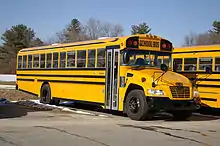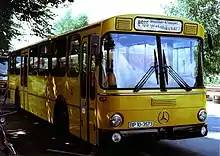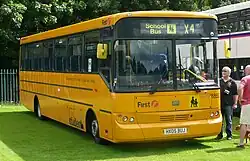School bus yellow
School bus yellow is a color that was specifically formulated for use on school buses in North America in 1939. Originally officially named National School Bus Chrome, the color is now officially known in Canada and the U.S. as National School Bus Glossy Yellow.
| National School Bus Glossy Yellow (AMS-STD 13432) | |
|---|---|
| Hex triplet | #ef8e00 |
| sRGBB (r, g, b) | (239, 142, 0) |
| HSV (h, s, v) | (36°, 100%, 94%) |
| CIELChuv (L, C, h) | (68, 104, 39°) |
| Source | AMS Standard Color Chart, National Highway Traffic Safety Administration |
| ISCC–NBS descriptor | Vivid yellow |
| B: Normalized to [0–255] (byte) | |
The original pigment for this color was monoclinic lead(II) chromate ("chrome yellow")[1] which had superior steel-protecting properties compared to other pigments. Because lead chromate was toxic because of both its lead and chromate content, and also subject to lead sulfide darkening after exposure to air, the pigment was initally replaced by a mixture of cadmium sulfide ("cadmium yellow") and enough cadmium orange or selenium pigments to produce the equivalent color. However, cadmium is also an expensive and toxic heavy metal, so now many saturated-color pigments are now azo-based organics.
Origin
In April 1939, Dr. Frank W. Cyr, a professor at Teachers College, Columbia University, in New York, organized a conference that established 44 uniform national design, construction, and safety standards for school buses in America, including the exterior body color.[2] The yellow-orange color was selected because black lettering on it was most legible in semi-darkness,[2] and because it was conspicuous at a distance and unusual enough to become associated with school buses and groups of children en route.[3]
Transportation officials from each of the 48 states, representatives from bus chassis and body manufacturers, and paint experts from DuPont and Pittsburgh Paints participated in the conference, which was funded by a $5,000 grant (more than $100,000 today[4]) from the Rockefeller Foundation.[2] The yellow-orange color, in three slight variants to allow for different paint formulations,[2] was adopted by the National Bureau of Standards (now the National Institute of Standards and Technology) as Federal Standard No. 595a, Color 13432.
Dr. Cyr became known as the "Father of the Yellow School Bus."[3]
Outside North America
North American-style yellow school buses are being introduced in some parts of the United Kingdom, prompted by corporate links to the American industry, for example First Student UK, or a desire to re-brand school buses, such as West Yorkshire Metro's Mybus.[5]
A similar shade of yellow was used in Santiago, Chile's bus lines between 1992 and 2007.
Examples
- Examples of buses in school bus yellow
 A typical school bus in the United States
A typical school bus in the United States Swedish Scania-Vabis postbus from mid-1920s
Swedish Scania-Vabis postbus from mid-1920s German postbus from 1925
German postbus from 1925 German Reichspost parcel delivery van from mid-1920s
German Reichspost parcel delivery van from mid-1920s Nineteenth century German Reichspost mail coach for both passengers and mail
Nineteenth century German Reichspost mail coach for both passengers and mail German postbus (1980s)
German postbus (1980s) Swiss Saurer postbus from 1953
Swiss Saurer postbus from 1953 A First Student UK school bus painted in American school bus yellow
A First Student UK school bus painted in American school bus yellow Mostly painted school bus yellow, this model in the USA has a white roof to reflect summer heat
Mostly painted school bus yellow, this model in the USA has a white roof to reflect summer heat.jpg.webp) A Hong Kong nanny van in yellow
A Hong Kong nanny van in yellow
See also
References
- Worobec, Mary Devine; Hogue, Cheryl (1992). Toxic Substances Controls Guide: Federal Regulation of Chemicals in the Environment. BNA Books. p. 13. ISBN 978-0-87179-752-0.
- Frank Cyr obituary, Columbia University
- Barron, James (February 19, 2013). "Why the School Bus Never Comes in Red or Green". The New York Times. Archived from the original on January 5, 2014. Retrieved March 13, 2021.
- "$5,000 in 1939 → 2022 | Inflation Calculator". www.in2013dollars.com. Retrieved October 16, 2022.
- Executive Summary – Mybus report on West Yorkshire Metro website, retrieved 2009-10-09
External links
- Highway Safety Program Guidelines archived from the National Highway Traffic Safety Administration.
- 100 Years of the School Bus archived from STN.